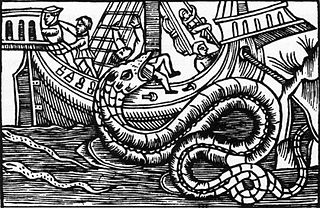
A sea serpent or sea dragon is a type of dragon sea monster described in various mythologies, most notably Mesopotamian (Tiamat), Judaeo-Christian (Leviathan), Greek, and Norse (Jörmungandr).

The humpback whale is a species of baleen whale. It is a rorqual and is the only species in the genus Megaptera. Adults range in length from 14–17 m (46–56 ft) and weigh up to 40 metric tons. The humpback has a distinctive body shape, with long pectoral fins and tubercles on its head. It is known for breaching and other distinctive surface behaviors, making it popular with whale watchers. Males produce a complex song typically lasting 4 to 33 minutes.

Sea monsters are beings from folklore believed to dwell in the sea and are often imagined to be of immense size. Marine monsters can take many forms, including sea dragons, sea serpents, or tentacled beasts. They can be slimy and scaly and are often pictured threatening ships or spouting jets of water. The definition of a "monster" is subjective; further, some sea monsters may have been based on scientifically accepted creatures, such as whales and types of giant and colossal squid.

Saanich is a district municipality on Vancouver Island in British Columbia, within the Greater Victoria area. The population was 117,735 at the 2021 census, making it the most populous municipality in the Capital Regional District and Vancouver Island, and the eighth-most populous in the province. The district adopted its name after the Saanich First Nation, meaning "emerging land" or "emerging people". The district acts as a bedroom community immediately to the north of Victoria, British Columbia.
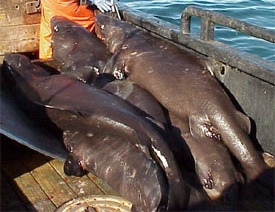
The Pacific sleeper shark is a sleeper shark of the family Somniosidae, found in the North Pacific on continental shelves and slopes in Arctic and temperate waters between latitudes 70°N and 22°N and in at least two places in the western tropical Pacific near Palau and the Solomon Islands, from the surface to 2,000 metres (6,600 ft) deep. The first evidence of the sharks in the western tropical Pacific emerged from a National Geographic video taken near the Solomon Islands in 2015. Its length is up to 4.4 m (14 ft), although it could possibly reach lengths in excess of 7 m (23 ft).

The New York–New Jersey Harbor Estuary has a variety of flora and fauna. Much of the harbor originally consisted of tidal marshes that have been dramatically transformed by the development of port facilities. The estuary itself supports a great variety of thriving estuarine aquatic species; contrary to popular stereotypes, New York Harbor and its adjacent, interdependent waters are very much alive, and steadily recovering from pollution; ecologically it is true that these waters were once dead or extremely toxic but after 45 years of cleaning the estuary is in a much better state than it has been in a hundred years. Tidal flow occurs as far north as Troy, over 150 miles away. The salt front can reach Poughkeepsie in drought conditions and is present in the lower reaches of the Raritan River for most of the year.

Trunko is the nickname for a large unidentified lump of flesh or a decomposed sea creature, a so-called "globster", reportedly sighted in Margate, South Africa on 25 October 1924. The initial source for Trunko was an article entitled "Fish Like A Polar Bear" published on 27 December 1924, edition of London's Daily Mail. The animal was reportedly first seen off the coast battling two killer whales, which fought the unusual creature for three hours. It used its tail to attack the whales and reportedly lifted itself out of the water by about 20 feet (6 m). One of the witnesses, South African farmer Hugh Ballance, described the animal as looking like a "giant polar bear" due to what was thought to be dense-white fur.

The basking shark is the second-largest living shark and fish, after the whale shark. It is one of three plankton-eating shark species, along with the whale shark and megamouth shark. Typically, basking sharks reach 7.9 m (26 ft) in length. It is usually greyish-brown, with mottled skin, with the inside of the mouth being white in colour. The caudal fin has a strong lateral keel and a crescent shape. Other common names include bone shark, elephant shark, sailfish, and sunfish. In Orkney, it is called hoe-mother, meaning "the mother of the picked dogfish."
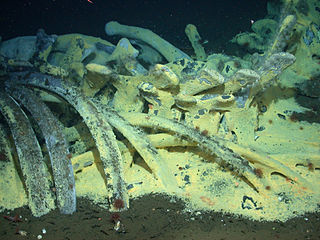
A whale fall occurs when the carcass of a whale has fallen onto the ocean floor at a depth greater than 1,000 m (3,300 ft), in the bathyal or abyssal zones. On the sea floor, these carcasses can create complex localized ecosystems that supply sustenance to deep-sea organisms for decades. This is unlike in shallower waters, where a whale carcass will be consumed by scavengers over a relatively short period of time. Whale falls were first observed in the late 1970s with the development of deep-sea robotic exploration. Since then, several natural and experimental whale falls have been monitored through the use of observations from submersibles and remotely operated underwater vehicles (ROVs) in order to understand patterns of ecological succession on the deep seafloor.

Oarfish are large, greatly elongated, pelagic lampriform fish belonging to the small family Regalecidae. Found in areas spanning from temperate ocean zones to tropical ones, yet rarely seen, the oarfish family contains three species in two genera. One of these, the giant oarfish, is the longest bony fish alive, growing up to 17 m (56 ft) in length.

A globster or blob is an unidentified organic mass that washes up on the shoreline of an ocean or other body of water. A globster is distinguished from a normal beached carcass by being hard to identify, at least by initial untrained observers, and by creating controversy as to its identity.
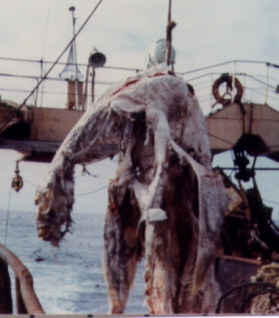
The Zuiyo-maru carcass was a corpse, caught by the Japanese fishing trawler Zuiyō Maru (瑞洋丸) off the coast of New Zealand in 1977. The carcass's peculiar appearance led to speculation that it might be the remains of a sea serpent or prehistoric plesiosaur.
The Stronsay Beast was a large globster that washed ashore on the island of Stronsay, in the Orkney Islands, Scotland, after a storm on 25 September 1808. The carcass measured 55 ft in length, without part of its tail. The Natural History Society of Edinburgh could not identify the carcass and decided it was a new species, probably a sea serpent. The Scottish naturalist Patrick Neill gave it the scientific name Halsydrus pontoppidani in honor of Erik Pontoppidan, who described sea serpents in a work published half a century before. The anatomist Sir Everard Home in London later dismissed the measurement, declaring it must have been around 30 ft, and deemed it to be a decayed basking shark. In 1849, Scottish professor John Goodsir in Edinburgh came to the same conclusion.

Cadboro Bay is a bay near the southern tip of Vancouver Island and its adjacent neighbourhood in the municipalities of Saanich and Oak Bay in Greater Victoria, British Columbia, Canada.
The wildlife of Alaska is both diverse and abundant. The Alaskan Peninsula provides an important habitat for fish, mammals, reptiles, and birds. At the top of the food chain are the bears. Alaska contains about 70% of the total North American brown bear population and the majority of the grizzly bears, as well as black bears and Kodiak bears. In winter, polar bears can be found in the Kuskokwim Delta, St. Matthew Island, and at the southernmost portion of St. Lawrence Island. Other major mammals include moose and caribou, bison, wolves and wolverines, foxes, otters and beavers. Fish species are extensive, including: salmon, graylings, char, rainbow and lake trout, northern pike, halibut, pollock, and burbot. The bird population consists of hundreds of species, including: bald eagles, owls, falcons, ravens, ducks, geese, swans, and the passerines. Sea lions, seals, sea otters, and migratory whales are often found close to shore and in offshore waters. The Alaskan waters are home to two species of turtles, the leatherback sea turtle and the green sea turtle. Alaska has two species of frogs, the Columbia spotted frog and wood frog, plus two introduced species, the Pacific tree frog and the red-legged frog. The only species of toad in Alaska is the western toad. There are over 3,000 recorded species of marine macroinvertebrates inhabiting the marine waters, the most common being the various species of shrimp, crab, lobster, and sponge.
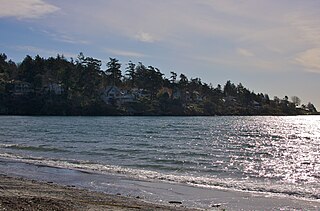
Ten Mile Point is a neighbourhood in the District of Saanich in Victoria, British Columbia, and is the most easterly point on Vancouver Island. Ten Mile Point was so named because it was ten nautical miles from what was at the time the headquarters of the Pacific Station of the Royal Navy. Ten Mile Point is a wooded peninsula that forms one side of Cadboro Bay, the home of the Royal Victoria Yacht Club and the mythical Cadborosaurus sea monster. Cadboro Point is located on the east part of this peninsula. Prevost Hill was named after James Charles Prevost, British commissioner in the negotiations to settle the San Juan boundary dispute. Prevost Hill is the highest elevation on Ten Mile Point and is known informally in the neighbourhood as "Minnie Mountain". Prevost Hill is the location for a subdivision within Ten Mile Point called "Wedgewood Point" or "Wedgewood Estates". A small wooded island, "Flower Island", almost touches the southern shore of Ten Mile Point. Ten Mile Point has many secluded beaches and coves.

A water horse is a mythical creature, such as the Ceffyl Dŵr, Capaill Uisce, the bäckahäst and kelpie.
Northern Mysteries is a docudrama-style television program that retells some of the stranger events in Canadian history, dealing with ghosts, paranormal events, lost treasures and bizarre murders. Hosted by Kenneth Welsh each episode usually tackles two events or subjects, by discussing with journalists, the police and eyewitnesses a complete account of what happened, as well as re-enacting the events for entertainment purposes.

A drift whale is a cetacean mammal that has died at sea and floated into shore. This is in contrast to a beached or stranded whale, which reaches land alive and may die there or regain safety in the ocean. Most cetaceans that die, from natural causes or predators, do not wind up on land; most die far offshore and sink deep to become novel ecological zones known as whale falls. Some species that wash ashore are scientifically dolphins, i.e. members of the family Delphinidae, but for ease of use, this article treats them all as "drift whales". For example, one species notorious for mass strandings is the pilot whale, also known as "blackfish", which is taxonomically a dolphin.
The Dead Boats Disposal Society (DBDS) is a non-profit society dedicated to the removal and disposal of abandoned boats and marine debris from shorelines in British Columbia, Canada. The Victoria-based Society has hauled 124 boats out of the water since 2017, most from bays and inlets in the Capital Regional District from Sooke to the Gulf Islands. By February 2020, the group had removed 89,300 metric tonnes of marine debris.
















